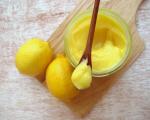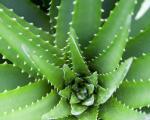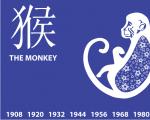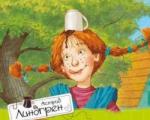Developing crochet cube ideas. Knitted toy “Educational cube” (master class)
Hello! My name is Liza Matveeva, I live in the city of Astrakhan. I recently became interested in knitting. I knit mainly for my little daughter. I want to show you one of my works.
I have long wanted to knit a developmental cube for my daughter; I found a lot of interesting ideas on the Internet, some of which I later implemented.
In this work I used hooks No. 2 and No. 4, remnants of threads of various colors, mostly bright ones, some beads of different sizes and Velcro. The size of the cube faces is 14*14cm. The main pattern is regular single crochets.
Side 1: Geometric shapes with Velcro. I knitted a circle, a square and a triangle, and also embroidered the outlines of the shapes on the cube itself.

- *** Crochet flower patterns for decorating products
Side 2: Volumetric sun with rays. Filling: a little padding polyester and a piece of rustling film. As a result, when you press the sun, you get a rustling sound.

Side 3: Rainbow. True, what I got was not a rainbow at all, I used more than 7 colors in my work.
Side 4: Flowers in the meadow. Each flower is attached to the cube with beads, the flowers can be swapped. Instead of beads, you can use buttons. The flowers are also attached to the cube with a chain of air loops. This is so that the child does not lose parts of the cube while playing.
Side 5: The fish that hides behind the lacing. The tail of the fish is a chain of air loops, the eyes are small beads. You can also use a zipper or buttons instead of lacing.
Side 6: Velcro pyramid. To keep the cube in shape, it is best to fill it with foam rubber.

For a beautiful multi-colored cube we will need threads of six colors. Threads need to be chosen in such colors that, when looking at them, the baby does not confuse them with others and can do it without any problems. For example, blue should be exactly blue, and not turquoise or cyan. For my cube, I took threads in four main colors from Lanoso Papillon: 50% cotton, 50% viscose. Precisely because of the color saturation. I had white and black threads from YarnArt.
How to crochet a toy?
We knit a square: for this we cast on 23 (25 for YarnArt) loops. I knitted in two threads for greater density.
We start the second row with a chain loop and knit single crochets.

At the end of the second and subsequent rows, do not forget to make air loops.

In order for the fabric to be square, 23 (25) rows are needed.

We check the “squareness” of the canvas - fold it across, you should get a beautiful triangle.

Thus we knit 6 squares.

The time has come for the “dots” of the future crocheted cube toy, which the baby will then count. To do this, you need to cast on 4 air loops and close them in a ring. Knit 11 stitches directly into this ring using single crochets.

Then tie each loop with a single crochet, but in three places you need to knit two stitches from one, increasing the number of loops to 14.

You need to connect 20 black “dots” and one white one into a black square. You can sew these dots with black thread, or you can use fishing line - in my opinion, it’s faster.

Now you need to sew four squares together, I did this with black thread. The dots should be on the inside, as it is easier to sew the square from the inside out.

Sew on the “bottom” of the crocheted cube toy.

Then I took a white thread and sewed on a white square, leaving one side unsewn.

Through this side you need to turn the square right side out and fill it with silicone and threads.

DIY knitted toy “Cube “Learn colors, count!” ready!

Hello! My name is Maria, I am 23 years old, I live in Barnaul. I would like to show off one of my first crochet works, inspired by my little son.
- Children's hats, without adult models
The idea of a development cube came to my mind. I found a lot of different ideas online, some of which I applied in my work. And this is what I got.
Educational cube for my son. Edge size 16x16. Acrylic, Hook No. 3.5.
In my work I used acrylic yarn, a hook No. 3.5, children's appliques, Velcro, as well as various beads, pebbles, shells and interesting buttons.

1 side (blue) – sky:
The sun is rustling
The cloud is thundering, the rain is shuddering
Helicopter - you can take the hero for a ride
Rainbow - ribbons of different textures
Sunshine, cloud, Velcro helicopter. Hero – children's applique Krosh.



Side 2 (green) – flower meadow:
Flowers on buttons - help the hero collect them, learn how to unfasten and fasten them, learn to count to five
The car is on the road - it can be tightened, you can give the hero a ride, the wheels are on Velcro - you can change them
House on a button - play "Who's Hiding?"
Hero – children's applique Bee.


3rd side (blue) – sea:
The ship is being pulled over
Fishes on buttons - learning to unfasten and fasten
The bottom is made of shells and pebbles - you can move and count

4th side (lilac) – zippered pocket:
Learning to open and close a zipper

5th side (pink) – pocket with button:
You can fold removable appliques, we also learn how to unbutton and fasten a button



Side 6 (peach) – lacing, basic geometric shapes and colors:
Lacing - learning to lace and tie a bow
Basic geometric shapes on Velcro - learn the basic colors, attach the shapes to their place.
Thank you for your attention!
Soft, bright, with numerous interesting elements, producing rustling and ringing sounds.
A knitted educational cube is a toy that teaches a baby to explore the world, improves motor skills and helps to acquire skills necessary in everyday life. Such toys are not cheap, but after spending a little time, you can make a personalized cube for a girl with your own hands. A desired gift from a loving mother will easily conquer the baby and become her favorite toy. And if there is an older child in the family, then you can do creativity together.
Preparation of materials and tools
This master class provides instructions on how to create a knitted educational toy for a girl. If you have a boy or you like to sew more than knit, take a look. Taking decorating ideas from there, you will also get a toy for a guy with a knitted base.
To make a developing cube with your own hands, you will need the following materials and tools:
- children's cotton yarn, approximately 55 g for the base of the figure;
- children's yarn of different colors, about 50 g, for decorative elements;
- foam rubber in the shape of a cube with an edge length of 9.5-10 cm;
- rattles (hollow plastic beads with a bell inside) – 2 pcs.;
- flat plastic tweeter – 1 pc.;
- a plastic transparent lid from a jar of sour cream or yogurt;
- various beads, beads, elements for scrapbooking;
- nylon and twill ribbons of different colors, cotton lace;
- yellow felt, hard;
- transparent glue “moment”;
- scissors;
- Crochet hook;
- ruler;
- doll eyes with moving pupils, 5 mm in diameter – 1 pair, 2 mm in diameter – 1 pair;
- silver stopper, for cord, 1 pc.;
- red cord 20 cm long, 1 pc.;
- gypsy and bead needles.
Instructions for making and decorating

The optimal length of the edges of a cube is the value 10 cm. A toy of this size will not be bulky or heavy, which is extremely important since it is intended for a child aged 5 months and older.
First, you need to knit six identical blanks in the form of squares with a side of 10 cm. For them you need to take cotton yarn. If you don't know how to knit, just take suitable fabrics! This will be the basis of a developmental cube for your baby. Then start decorating each side.
The purpose of the toy is to develop fine motor skills and expand the child's tactile experience. This will not be difficult to achieve, using, for example, materials of different properties and structure.
Thus, a felt sun with rays made from different ribbons, cords, elastic threads, and a piece of cocktail straw will fully solve the problem. The rays can be made even more interesting if you attach a tied ring, a voluminous bead or a button of an original shape to them. Then the child will be truly interested in both looking at the sun and touching its elements.

An important skill for any girl is the ability to lace and tie bows. It is recommended to devote one side entirely to this task. Lacing can be decorated using delicate cotton lace, a thin cord for loops and an elegant organza ribbon. Decorative bows made from satin ribbons will help add a cute girlish touch to the cube.
Important so that all elements are securely sewn, because otherwise the child will easily and quickly tear them off or even want to taste them.

Try to make a very interesting rattling element for a children's educational cube with your own hands, using a transparent lid or body from some packaging. Place multi-colored beads, shells, decorations and other small items inside. They will make noise, rolling from place to place.
To make the decor look brighter, make a contrasting felt backing inside the lid. The cover itself should be sewn onto the surface using a gypsy needle using an overcast stitch.

Another sound effect can be easily achieved using a plastic squeaker sewn under a decorative applique, for example, an owl. Around it, place improvised stars made of large beads, as well as a smiling moon with eyes.
For the squeaker to work, you just need to press your finger on the owl’s abdomen. The child's fingers will practice strength when pressing, and will also become familiar with the texture of a knitted applique.

It is more convenient to carry the development cube in your hands if you make a neat knitted handle. It can be decorated with lace, and the junction with the cube part can be decorated with buttons.
On the same side of the cube for a girl, embroider the name of the owner, emphasizing that the toy is her personal, personalized, made in a single copy.
Here you can sew on a couple of interesting beads and buttons that look harmonious against the overall background of the product.
Another side should be reserved for the “magic bag”. This element will teach the girl to use the stopper placed on the cord. Having acquired this skill, she will be able to open the bag on her own and find out what is in it. Inside, place a knitted rattle bead, knitted and simple plastic rings, and a knitted curl. Everything should be bright, interesting, and attention-grabbing.


Having formed all the sides of the cube, connect them together. It is recommended to further decorate each corner by sewing on various beads, plastic rings and other little things. They will complete the image of an educational toy and make it bright and positive.
Place a foam cube inside the mold. It must be inserted into the workpiece before attaching the last side.
A self-made development cube should be washed exclusively by hand, very carefully, at a temperature not exceeding 30 degrees, and dried on a towel. When hung, the knitted fabric may become deformed, which will ruin the appearance of the product.
Homemade toys are safe, and the love invested during the work makes them a kind of amulets. Learn to knit and sew so that your child is surrounded by your care. Perhaps the process of making educational and other toys will captivate you and you will even start turning a new hobby into additional income. Calculate how much the craft will cost you and compare prices on sale!
A master class on making a developmental cube for a baby was prepared by Zabava Rodionova. Especially for the online magazine “Women’s Hobbies”.
Greetings, dear friends!
Today there is a joyful event on my blog - the opening of a new section "KNITTED TOYS"! Oh, I’ve been working towards this for a long time, but there’s no way I can put it off any longer - my granddaughter is growing up and the birth of a granddaughter is just around the corner! How can they live without grandma’s knitted toys? No way. 😉
I had never knitted toys before, so I decided to start with the easiest one. This is what it turned out to be, in my opinion. As you can see, this cube is not quite ordinary - it is round, like a square ball. Or like the first pancake, which is lumpy. 😉
But despite this, it still has not lost its developmental properties. And since I am not a greedy person, I am sharing the process of making a developmental cube with you, my dears! Catch Master Class in photos! 😉
Knitted toy “Educational cube” (master class)
Before you start working, decide on the colors of the yarn from which you will create knitted toy "Development cube" , there should be FIVE of them, but decide which ones exactly, of course, they should not be dark. 😉
You also need to prepare 21 BUTTONS, preferably larger and of different colors, and maybe shapes. I poured out all my button supplies in a heap and selected what I liked the most.
The work is being done . Well, now in more detail:
1. On needles No. 4 we cast on 22 loops with a thread of YELLOW color (“yolk”) yarn folded in half "Children's novelty" from "Pekhorka"(yarn is not expensive, you can find it). Next, we knit a square using garter stitch (a measuring tape should always be at hand for constant measurements), and bind off all the loops.

1. Knit a yellow square.
2. On the braids of one of the sides of the YELLOW square, we cast on 20 loops with a double thread of LIGHT GRAY color (this yarn turned out to be a little thicker, so you constantly need to take measurements so that all the faces of the cube (squares) are the same) . We knit a square in the same way, closing off all the loops.

2. We attach a gray one to the yellow square.
3. On the braids of the second side of the YELLOW square, using a double thread of BLUE color, we cast on the required number of loops. We knit a square, close the loops.

3. We tie a blue one to the yellow square.
4. Along the braids of one of the sides of the BLUE square, using a double thread of LIGHT LIGHT color, cast on the required number of loops, knit a square and bind off all the loops.

4. For blue - light green.
5. Along the braids of the second side of the BLUE square, we cast on the required number of loops with a CORAL thread, knit a square, close the loops.

5. We tie a coral one to the blue square.
6. Along the braids of the left side of the LIGHT LIGHT square, we pick up loops with a CORAL thread and knit a striped square, alternating all the colors used when knitting the squares.

6. For light green - a striped square.
7. Lay out the buttons on the surface of the unfolded cube so that each square contains: 1, 2, 3, 4, 5 and 6 buttons. We sew the buttons tighter. 😉

7. Sew the buttons tightly.
8. Sew development cube from the inside out along its ribs, leaving one edge unsewn. We turn the cube inside out and fill it with padding polyester through the remaining slit-like hole, then sew it together.

8. Sew the cube and fill it with padding polyester.
Master Class has come to an end! I don't know what will happen for you, but for me development cube it turned out to look like a ball. At first I was a little upset, but then I cheered: there was an exclusive!
So what are the educational properties of this knitted toy? Playing with a baby with a knitted cube-ball:
- introduce him to five different colors;
- with stripes (repeating colors);
- learn to count buttons;
- we introduce you to the shape of buttons (as you noticed, there are not only round ones);
- with their color;
- with traffic light colors (on a gray background);
- we learn to add numbers (2 white + 3 gray buttons on a blue background).
In general, there is room for your imagination to run wild, you can come up with something else! 😉
This is so interesting knitted toy “Educational cube” I did it. I will be glad to know your opinion, dears! Well, what if this knitted toy If you still liked it, tell your friends and acquaintances about it by clicking on the social buttons. networks! 😉
And if you haven't signed up to receive new articles from my blog yet, now is the time to do so! You understand that the first toy should be followed by the second. 😉
With respect and love to you,



